
25 Sep The Brown Trout Paradox
My angling career began when I was a kid in rural Upstate New York, catching pan-sized native brook trout. (As a measuring tool, the pan didn’t have to be very big.) Around the time I was 9 years old, I began transitioning from worms to dry flies. The choice of surface flies wasn’t a matter of principle: In the 1950s, hardly anyone knew anything about fishing nymph imitations. I certainly didn’t.
On one midsummer adventure, I headed upstream while my dad went down. After 100 yards of dead water, I arrived on a high bank overlooking a deep pool. As I studied the water, I saw a bug (a mayfly, in retrospect) vanish in a dimple against the opposite bank. Game on.
I wasn’t worried about matching the hatch because I didn’t know anything about hatches. By modern standards, my Royal Wulff would be classified as a crude imitation of nothing in nature. Skeptics should remember what Livingston, Montana’s late, great Dan Bailey had to say on the subject: “A selective trout is one that won’t hit a Royal Wulff.” Furthermore, I had tied it myself.
I measured the distance and fired away. Since I was casting across the current and hadn’t learned to mend a fly line yet, the strike was as undeserved as it was exciting. When I hauled the fish up the bank, I immediately made two observations. It was the biggest fish I’d ever caught, and it wasn’t a brook trout.
Thus began a 70-year love affair with dry-fly fishing and Salmo trutta — the brown trout.

Despite Montana’s reputation as an angling mecca, surprisingly few of our gamefish are native to the state. Except for a small population of redband rainbow trout and a few glacial relic lake trout populations, our only widely distributed native trout are bull trout (actually a char) and two species of cutthroats.
Then, anglers craving variety took matters into their own hands.
In 1889, hatchery-reared rainbow trout were introduced into the Madison River. Rainbows derive from Pacific salmon, with whom they share the generic name Oncorhynchus. These were the first of their kind in Montana east of the Continental Divide. Evidently reasoning that if one popular newcomer was good, then two would be better, someone planted brown trout in the Firehole River a year later. Today, these two species are central to Montana’s popularity as a fly- fishing destination. A River Runs Through It would not have been written without them.
Despite their similarities on the end of a line, browns and rainbows are very different fish. Browns were not only foreign to Montana but to the entire Western Hemisphere. Their native range extends from the British Isles through continental Europe to western Asia. In contrast to rainbows and cutthroats, they originated in the Atlantic, hence the generic name Salmo, which they share with Atlantic salmon.
Anglers seem to have loved them from the start, as noted in classical angling treatises by English writers Dame Julia Brenner of the 15th century and Izaak Walton, author of the 1653 title The Compleat Angler. No one valued them more than the British, who were largely responsible for their eventual worldwide dispersion. Over decades of adventure travel, I realized that British colonists inevitably brought three things with them wherever they settled: tea, overcooked meat, and brown trout. That’s how browns came to inhabit suitable waters from South Africa to New Zealand.
Despite their popularity among fly-rod anglers, there is one significant problem with Montana brown trout: They’re eating our state fish.
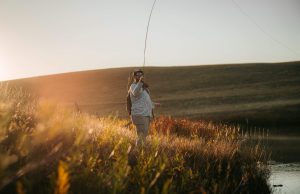
A few last casts before the October sun sets complete another perfect Montana day.
Like all trout, browns enjoy a diet heavily dependent on aquatic insects. However, they are notably aggressive carnivores, and big ones will attack almost anything that swims, from cutthroat fry to baby ducks. Browns and our beloved cutthroats just don’t play well together.
A decade ago, Bozeman-based fisheries biologists working with the U.S. Geological Survey studied these interactions in two small Yellowstone National Park streams holding both browns and native cutthroats. Sampling studies from the 1980s had shown more browns than cutthroats in the streams’ lower reaches, while cutthroats predominated in the headwaters. Their 2012 study showed that the browns had become numerically dominant throughout. They planted some cutthroats above a waterfall that acted as a physical barrier to browns farther downstream. Subsequent comparison of the two cutthroat populations — one shared with browns and one without — showed far fewer juvenile cutthroats where the two overlapped. Furthermore, the isolated cutthroats grew significantly larger and faster than previously observed.
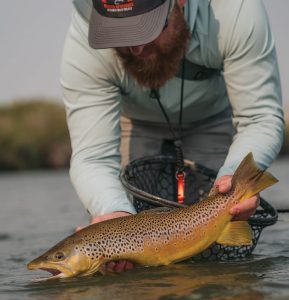
Drew Mumford displays a perfect specimen of a male brown trout.
This and similar studies demonstrate that predation isn’t the only reason cutthroat numbers decline in the presence of browns. Competition for limited food sources favors the more aggressive brown trout. From agricultural dewatering to climate change, a variety of factors are also contributing to rising temperatures in many Montana trout streams. Rainbows and cutthroats do best in water temperatures around 55 degrees Fahrenheit, while browns thrive between 60 and 65 degrees. Thus begins a vicious cycle. As environmental changes increasingly favor the browns, there are more browns to eat more juvenile cutthroats.
In some places where brown trout have been introduced, they are regarded as just another invasive alien species. One reason why browns enjoyed such a prominent status in British angling history is that anglers got to enjoy them in their sea-run form. Like steelhead, the anadromous version of rainbow trout, most salmonids that spend time in saltwater grow larger and stronger than their inland counterparts.
Anglers attempted to introduce sea-run browns in multiple locations around the world, but only succeeded in one: southern Argentina. When I chased them in Tierra del Fuego, the angling lived up to expectations. However, alien browns had displaced indigenous fish species. Some Argentines were arguing for their removal even though the fish they threatened were of little angling value. Responsible science or lingering resentment over the Falkland Islands War? Probably a bit of both.
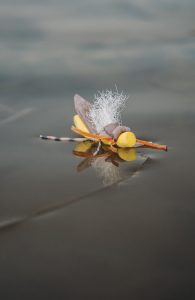
Lance Egan’s Bionic Hopper is an excellent imitation to fool hungry trout taking grasshoppers on the surface.
A basic biological principle holds that when a species in an isolated ecosystem free of competitive pressure suddenly faces a better-adapted alien, the native loses the Darwinian battle. That’s what happened to Hawaii’s native forest birds after European contact. It would be a tragedy to see it happen to our cutthroats.
Choosing a favorite gamefish is like choosing a favorite child: futile, conflicting, and ultimately unfair to something that has brought you joy. I’m not going to tackle that impossible choice here. However, I can’t think of a freshwater species I’ve enjoyed more than brown trout.
While it’s hard to grasp the concept of intelligence in fish, the consensus among anglers holds that browns are somehow smarter than other trout. Though an impression rather than an objective fact, the opinion is so widely shared among experienced anglers that there must be something to it. During a busy mayfly hatch, most of us have seen rainbows strike any good imitation while the browns next to them rise halfway to the same fly pattern, study the artificial, and drop back down to the streambed without striking. Why value fish that are hard to catch? After landing — and hopefully releasing — countless trout, meeting a challenge often becomes more important than wrangling another fish into the net.
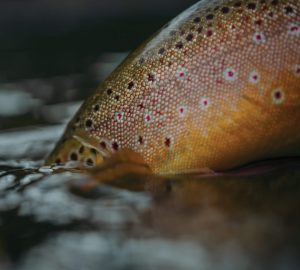
A close examination of the intricate patterns of a wild brown trout before its quick release back into the depths seems intimate proof enough of the wonder of nature.
Visual appeal is another consideration. Browns face stiff competition for the best-dressed title. Nothing appeals to a coastal angler like a bright salmon fresh from the sea, even though (and perhaps because) its color is uniform silver throughout. On the other hand, those more impressed by an artist’s color palette would find it hard to beat an arctic char dressed up in its fall pre-spawn hues. But beauty lies in the eye of the beholder, and although browns are neither shiny nor gaudy, I find them beautiful, especially the big ones. Their tawny sides make them the only trout that looks warm. Their scarlet and black spots may not be as dramatic as those on spawning char, but their subtlety has its own appeal. Finally, there is nothing more satisfying than the golden flash beside a drifting nymph imitation that announces you’ve finally fooled a brown.
August can be a quirky month on my favorite spring creek. The midday mayfly hatches have faded along with the evening caddis rise. But hope springs eternal, and I’ve waited for the perfect day to explore my favorite alternative. Bright sunshine, a brisk wind, and buzzing grasshoppers greet the dogs and me during the morning walk.
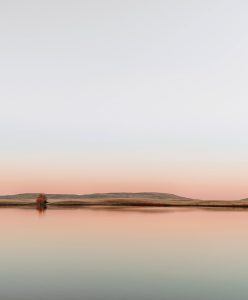
Twilight on a peaceful pond is a slice of picturesque Montana.
As I park my truck and walk down to the water, the gentle sound of distant combines fills the air, reminding me that upland bird season lies just two weeks away. The trout will either be hitting hoppers or they won’t, and I’ve found an easy way to tell the difference before I bother with my fly rod. On the walk through the field from the truck, I catch a dozen hoppers and stuff them in a vest pocket. Upon arriving at an abandoned farm bridge, I pick my way across the remains until I’ve reached a midway point that offers a commanding view of the current below.
Although I can’t see any fish feeding downstream, I’m not discouraged. Hopper fishing is an on-and-off affair, and sometimes it just takes the right wind gust to start the dinner party. After extracting a hopper from my pocket, I drop it midstream and watch it float out of sight around the next bend without attracting any attention. However, indifference from the fish may simply reflect a sampling error on my part. When a hopper miscalculates and winds up in a trout stream, it usually lands close to the bank. And the fish know it.
After repositioning, I drop a second hopper in a current line that should carry it right next to an overhanging bank. Sure enough. Paradoxically, the rise seems subtler than it likely would have been for a mayfly a fraction of the hopper’s size, but I’ve seen that before.
A 50-yard walk downstream leads to a favorite riffle where I rig up. I’ve seen hopper patterns tied so meticulously that one could fool me if I saw it on a blade of grass. I’m more of an impressionist at the tying bench. My hoppers are big, buoyant, and fluffy, tied with deer hair and turkey feathers obtained with my own bow. As suggested earlier, some of fishing’s best moments don’t involve catching fish.

Fall colors abound in all their glory on both the foliage and this jaw-dropping brown trout.
The opposite bank lies just 30 feet away. I lay the fly as close to it as I can without catching thistles, even though the water there isn’t more than ankle deep. A brief golden flash identifies the attacker as a brown. It’s a vigorous fish, but despite the list of attributes outlined earlier, I don’t think browns fight as hard or acrobatically as rainbows from the same stream. Even though it’s nearly 20 inches long and I’m fishing with my light 3-weight rod, I have it finning quietly at my feet in no time.
Splendid outdoor resource or destructive alien invader? As with walleyes, Hungarian partridge, and pheasants, browns are a bit of both. Montana wouldn’t be Montana without them, I guess. The best approach to the dilemma will likely be management by anglers and biologists working together to keep the browns where they can do the least harm while doing whatever it takes to preserve our native cutthroats. I know Montana wouldn’t be the same without them.
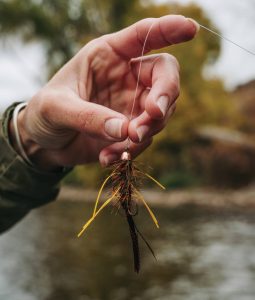
The Autumn Splendor is a fitting name for a streamer destined to fool fish looking to pack on calories for winter.
A central Montana resident since 1973, E. Donnall Thomas Jr. has been everything from a physician to a bear hunting guide in Alaska. He writes about the outdoors for numerous publications and lives in Lewistown, Montana with his wife, Lori, and their bird dogs.
Jakob Burleson is a photographer from the front range of Colorado. Alongside his freelance and personal projects, he works in house for the fly-fishing brand Umpqua Feather Merchants, where he enjoys creating photographs of iconic fly patterns, legendary fly fishermen, and the world’s most innovative fly tiers. His work has graced the pages of The Flyfish Journal, Trout, Fly Fisherman, Colorado Outdoors, Montana Outdoors, John Barr’s Out of the Box, Landon Mayer’s Guide Flies, and several years of Umpqua’s annual product catalog.



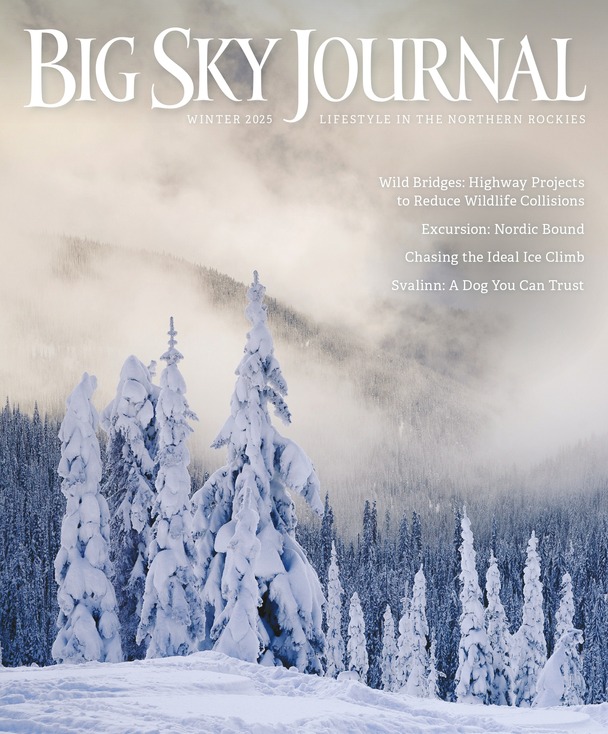
No Comments